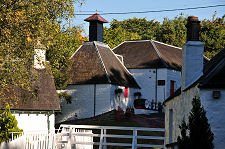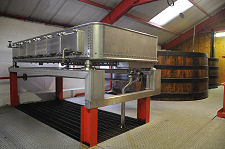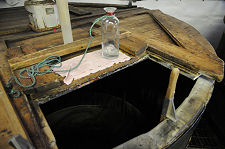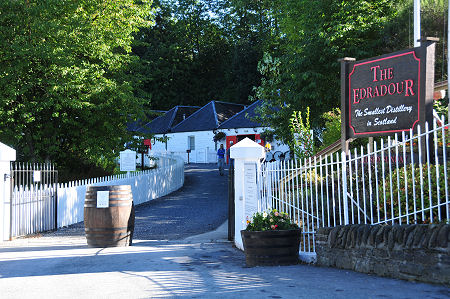 Edradour Distillery Seen from the Road |
Lying in the hills overlooking Pitlochry from the east, is Edradour Distillery, which until the advent of the new wave of micro-distilleries was the smallest in Scotland. Edradour is the last long-established survivor of the old tradition of farmhouse distilleries, and its annual output of 240,000 bottles per year would emerge from the stills of a large Speyside distillery in less than a week.
Distilling in the Highlands was for many centuries carried out by a large number of very small-scale, usually illegal, stills in farms, caves or wherever else they could find that was hidden from the vigilant excisemen and the troops that supported them. Everything changed with the Excise Act of 1823, which allowed small Highland distilleries to compete on equal terms with the increasingly industrial Lowland distillers.
The 1823 Act also introduced a minimum legal size for a still, just large enough to be difficult to transport and hide. The stills at Edradour just above the minimum size allowed in the Act. This minimum has been removed in recent years, leading to the launch of many micro-distilleries.
Edradour distillery came into being, as a legal operation at least, in 1825. It is one of the most beautifully arranged distilleries in Scotland, comprising a neat whitewashed collection of buildings located in a small rising valley, either side of the burn that provides its water. In mid 2002 the burn provided rather too much water, washing away most of the garden and car park after very heavy rain.
It's not uncommon to find distilleries that employ more people in the visitor centre than in production: this is certainly the case here, where the production side is run by just three men. The rest of the staff are engaged in the shop or in conducting the popular tours.
The "standard" single malt now produced by Edradour is a ten-year-old, a highly rated Highland malt that for us carries a distinct and attractive overtone of the salt and seaweed much more characteristic of an island whisky. You can find out more about Making Malt Whisky from our series of feature pages showing the stages in the process.
Edradour has changed hands a number of times during its history. After 20 years under the ownership of Pernod Ricard it was brought in 2002 for £5.4m by the Signatory Vintage Scotch Whisky Company, the well established Edinburgh based whisky bottling company.
In its earlier life Edradour had a fairly colourful history, and much of its production was alleged to have ended up in the USA by various means during the prohibition era of the 1920s. It has also been alleged that during this period the distillery was briefly and indirectly owned by the Mafia. Whatever the truth of this, the US market remained an important one for Edradour.
One result of this was that when the cargo ship the SS Politician struck rocks just off the north shore of Eriskay in the Western Isles on 5 February 1941, en route to New York, a significant proportion of the content of the 264,000 bottles of Scotch Whisky in its hold was produced at Edradour. As soon as the crew were safe, the islanders set to work saving the cargo.
It is thought that over 2,000 cases or 24,000 bottles were liberated before the authorities arrived on the scene. In the aftermath, police and customs officers searched the entire island and several islanders were actually jailed for theft, not something advertised in Compton Mackenzie's bestselling 1947 novel "Whisky Galore" based on the story of the SS Politician, or the film it spawned.
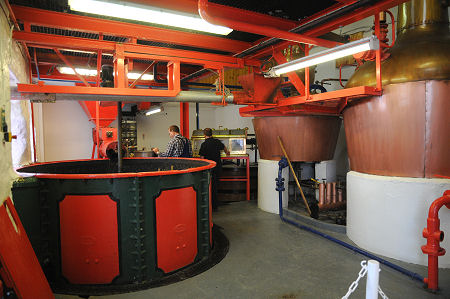 The Stills and the Mash Tun |

|
|
|
Visitor InformationView Location on MapSTB 5 Star Visitor Attraction. Pitlochry, PH16 5JP. Tel: 01796 472095. Grid Ref: NN 959 580 www.edradour.co.uk Opening Hours Admission & Tours What3Words Location: ///paused.plants.routs |
 The Still House, on the Right |
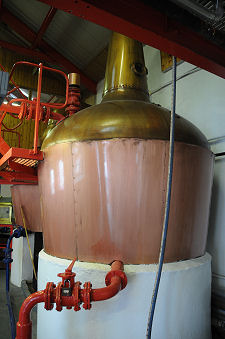 One of the Stills |
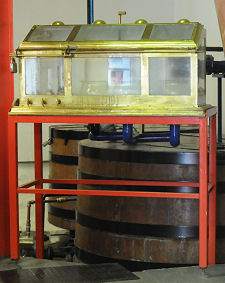 The Spirit Safe |
